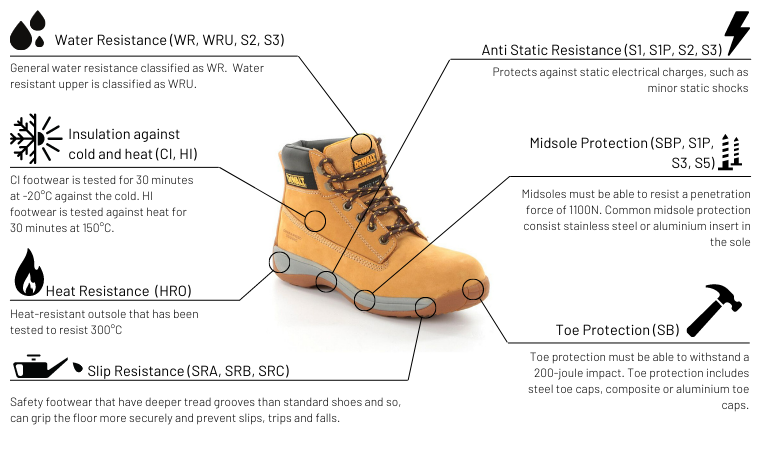Protective footwear is important due to the variety of industry-based hazards that can cause injuries to your feet. These vary from crushed or broken bones, punctures to the sole, burns, and sprained or twisted ankles which can occur if you aren’t equipped with the correct type of protective footwear.

| Category |
EN ISO 20345 Rating |
|
SB SBP |
Basic safety footwear meets the minimum standards of a 200-joule safety toe cap protecting against impact injury to the toes caused by falling objects.
P stands for penetration resistance midsole.
|
|
S1 S1P |
As per SB, plus antistatic properties, resistance to fuel oil and energy absorbing heel unit.
P stands for penetration resistance midsole.
|
|
S2 |
As per S1 with added water penetration and absorption resistance.
|
|
S3 |
As per S2 with added cleated outsole and penetration resistance.
|
|
S4 |
As per S1 but is moulded from a polymer or rubber that makes them completely waterproof and leak-proof.
|
|
S5 |
As per S4 with added midsole penetration resistance.
|
Slip Resistance Rating
|
SRA |
Footwear that has been tested on a ceramic tile wetted with a dilute soap solution.
|
|
SRB |
Slip resistance is tested on a Steel plate that has been saturated with Glycerol.
|
|
SRC |
Tested under SRA and SRB conditions.
|
Additional Classification
|
P |
Penetration resistance.
|
|
CI |
Provides insulation against the cold for 30 minutes at -20°C
|
|
HI |
Provides heat resistance for 30 minutes minimum of 150°C
|
|
HRO |
The outsole has been tested for heat resistance against 300°C on contact.
|
|
WRU |
T Water-resistance upper.
|
|
WR |
Footwear can be worn in outdoor environments exposed to sustained wet weather and not leak.
|